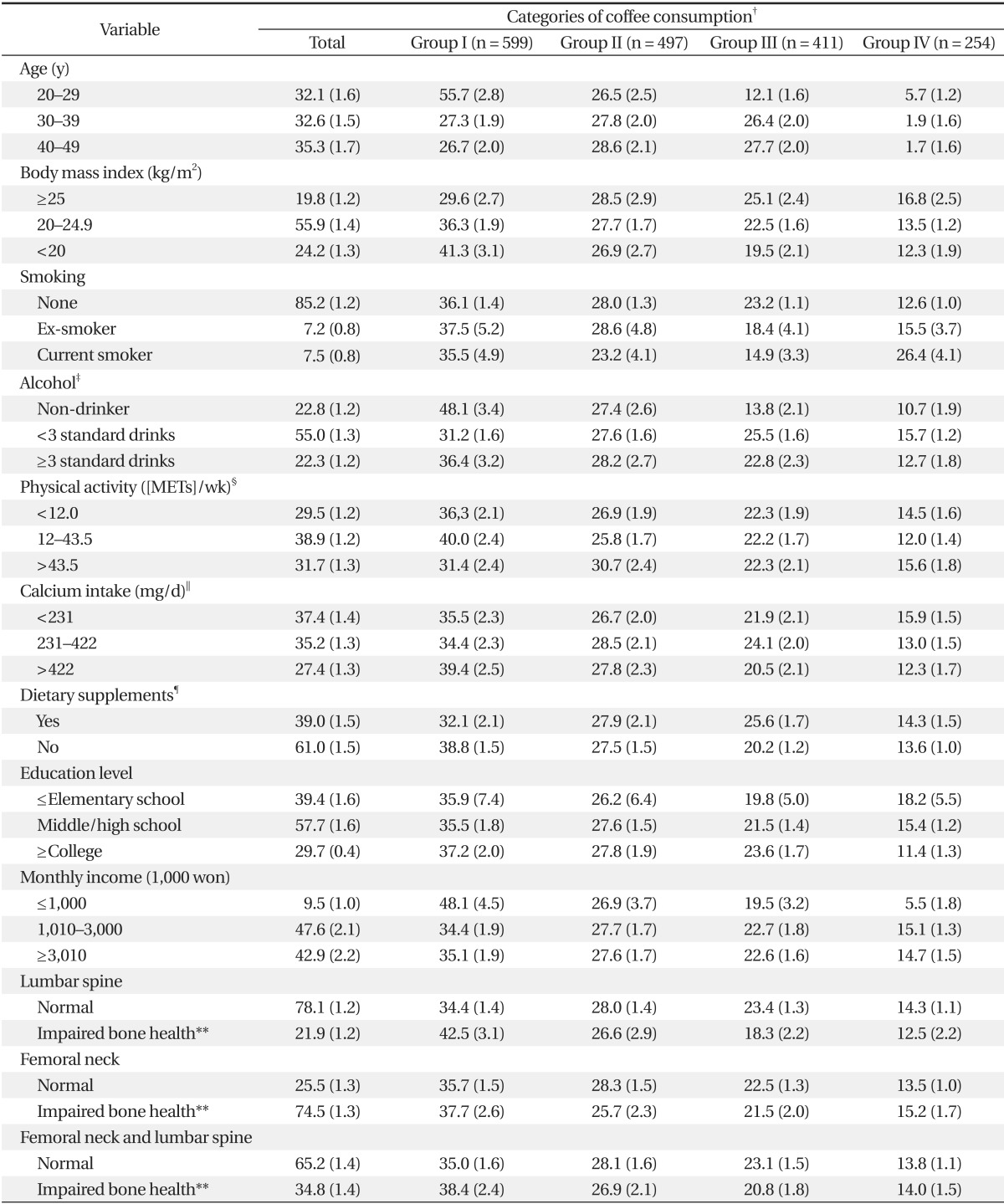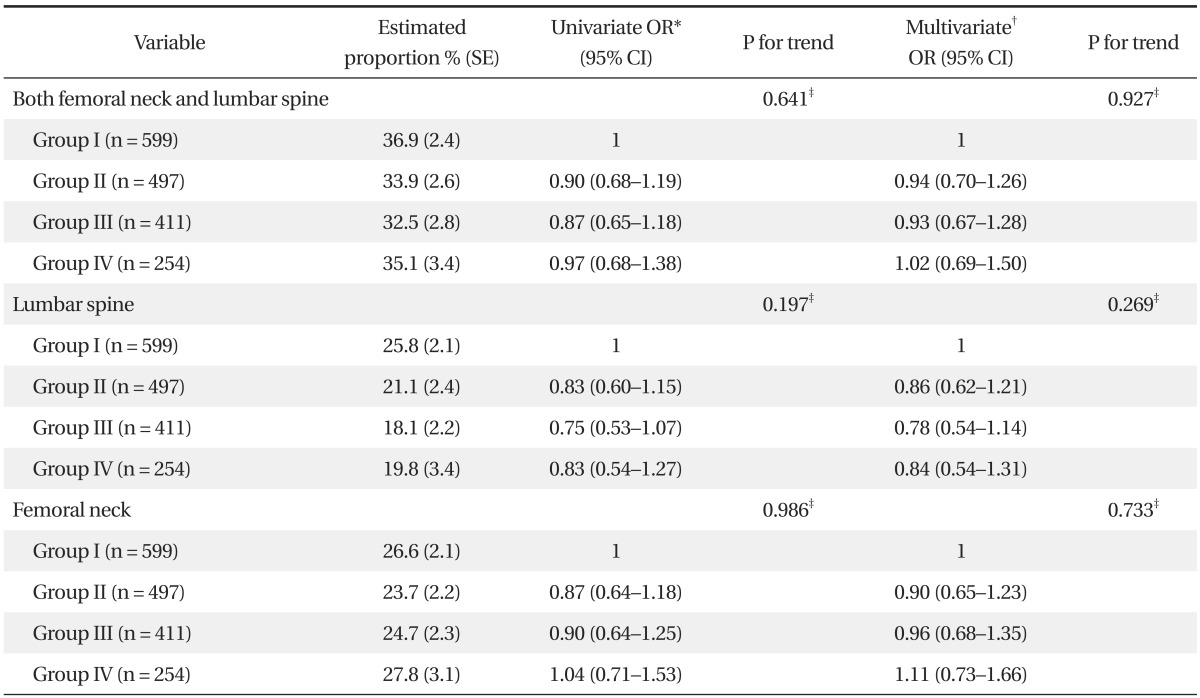1. Mandel HG. Update on caffeine consumption, disposition and action. Food Chem Toxicol 2002;40:1231-1234. PMID:
12204386.


2. United States Department of Agriculture, Foreign Agricultural Service. Coffee: world markets and trade. Washington (DC): United States Department of Agriculture, Foreign Agricultural Service; 2012.
3. Grigg D. The worlds of tea and coffee: patterns of consumption. GeoJournal 2002;57:283-294.

4. Hallstr├Čm H, Wolk A, Glynn A, Michaelsson K. Coffee, tea and caffeine consumption in relation to osteoporotic fracture risk in a cohort of Swedish women. Osteoporos Int 2006;17:1055-1064. PMID:
16758142.


5. Shin CS, Choi HJ, Kim MJ, Kim JT, Yu SH, Koo BK, et al. Prevalence and risk factors of osteoporosis in Korea: a community-based cohort study with lumbar spine and hip bone mineral density. Bone 2010;47:378-387. PMID:
20362081.


6. Barrett-Connor E, Siris ES, Wehren LE, Miller PD, Abbott TA, Berger ML, et al. Osteoporosis and fracture risk in women of different ethnic groups. J Bone Miner Res 2005;20:185-194. PMID:
15647811.


7. Fatima M, Nawaz H, Kassi M, Rehman R, Kasi PM, Kassi M, et al. Determining the risk factors and prevalence of osteoporosis using quantitative ultrasonography in Pakistani adult women. Singapore Med J 2009;50:20-28. PMID:
19224080.

8. Karunanayake AL, Pinidiyapathirage MJ, Wickremasinghe AR. Prevalence and predictors of osteoporosis in an urban Sri Lankan population. Int J Rheum Dis 2010;13:385-390. PMID:
21199475.


9. Ongphiphadhanakul B, Chanprasertyothin S, Payattikul P, Saetung S, Rajatanavin R. The implication of assessing a polymorphism in estrogen receptor alpha gene in the risk assessment of osteoporosis using a screening tool for osteoporosis in Asians. Osteoporos Int 2003;14:863-867. PMID:
12961063.


10. Nakajima T, Ota N, Shirai Y, Hata A, Yoshida H, Suzuki T, et al. Ethnic difference in contribution of Sp1 site variation of COLIA1 gene in genetic predisposition to osteoporosis. Calcif Tissue Int 1999;65:352-353. PMID:
10541758.


11. Megyesi MS, Hunt LM, Brody H. A critical review of racial/ethnic variables in osteoporosis and bone density research. Osteoporos Int 2011;22:1669-1679. PMID:
21207012.


12. Ilich JZ, Kerstetter JE. Nutrition in bone health revisited: a story beyond calcium. J Am Coll Nutr 2000;19:715-737. PMID:
11194525.


13. Ahn YJ. Survey on the actual condition for adults' knowledge, attitude, and intake of caffeinated beverages [dissertation]. Daegu: Keimyung University; 2011.
14. Kim MS, Koo JO. Analysis of factors affecting bone mineral density with different age among adult women in Seoul area. Korean J Community Nutr 2007;12:559-568.
15. Ganry O, Baudoin C, Fardellone P. Effect of alcohol intake on bone mineral density in elderly women: The EPIDOS Study. Epidemiologie de l'Osteoporose. Am J Epidemiol 2000;151:773-780. PMID:
10965974.


16. Felson DT, Zhang Y, Hannan MT, Kannel WB, Kiel DP. Alcohol intake and bone mineral density in elderly men and women. The Framingham Study. Am J Epidemiol 1995;142:485-492. PMID:
7677127.


17. Hallal PC, Victora CG. Reliability and validity of the International Physical Activity Questionnaire (IPAQ). Med Sci Sports Exerc 2004;36:556PMID:
15076800.


18. De Laet C, Kanis JA, Oden A, Johanson H, Johnell O, Delmas P, et al. Body mass index as a predictor of fracture risk: a meta-analysis. Osteoporos Int 2005;16:1330-1338. PMID:
15928804.


19. Lewiecki EM, Gordon CM, Baim S, Leonard MB, Bishop NJ, Bianchi ML, et al. International society for clinical densitometry 2007 adult and pediatric official positions. Bone 2008;43:1115-1121. PMID:
18793764.


20. National Osteoporosis Foundation. NOF responds to the U.S. Preventive Services Task Force recommendations on calcium and vitamin D [Internet]. Washington (DC): National Osteoporosis Foundation; 2013. [cited 2013 Feb 26]. Available from:
http://www.nof.org
21. Griffin MG, Rupich RC, Avioli LV, Pacifici R. A comparison of dual energy radiography measurements at the lumbar spine and proximal femur for the diagnosis of osteoporosis. J Clin Endocrinol Metab 1991;73:1164-1169. PMID:
1955496.


22. Hannan MT, Felson DT, Dawson-Hughes B, Tucker KL, Cupples LA, Wilson PW, et al. Risk factors for longitudinal bone loss in elderly men and women: the Framingham Osteoporosis Study. J Bone Miner Res 2000;15:710-720. PMID:
10780863.


23. Lloyd T, Johnson-Rollings N, Eggli DF, Kieselhorst K, Mauger EA, Cusatis DC. Bone status among postmenopausal women with different habitual caffeine intakes: a longitudinal investigation. J Am Coll Nutr 2000;19:256-261. PMID:
10763907.


24. Hallstr├Čm H, Melhus H, Glynn A, Lind L, Syvanen AC, Michaelsson K. Coffee consumption and CYP1A2 genotype in relation to bone mineral density of the proximal femur in elderly men and women: a cohort study. Nutr Metab (Lond) 2010;7:12PMID:
20175915.



25. Heaney RP. Effects of caffeine on bone and the calcium economy. Food Chem Toxicol 2002;40:1263-1270. PMID:
12204390.


26. Chouinard LE, Randall Simpson J, Buchholz AC. Predictors of bone mineral density in a convenience sample of young Caucasian adults living in southern Ontario. Appl Physiol Nutr Metab 2012;37:706-714. PMID:
22574749.


27. Conlisk AJ, Galuska DA. Is caffeine associated with bone mineral density in young adult women? Prev Med 2000;31:562-568. PMID:
11071837.


28. Farah A, de Paulis T, Moreira DP, Trugo LC, Martin PR. Chlorogenic acids and lactones in regular and water-decaffeinated arabica coffees. J Agric Food Chem 2006;54:374-381. PMID:
16417293.


29. Kim MJ. Economics of coffee. Seoul: Jihoon Publishing House; 2008.
30. Harris SS, Dawson-Hughes B. Caffeine and bone loss in healthy postmenopausal women. Am J Clin Nutr 1994;60:573-578. PMID:
8092093.












